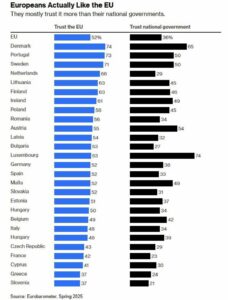One of the most remarkable phenomena in Slovenian politics is that new governments, regardless of how disastrously they govern, maintain stable (albeit low) support. At least that is what Slovenian public opinion pollsters would have us believe. But what is the real sentiment of Slovenian voters? Perhaps we will only understand it when we examine foreign surveys. One such survey was the recent European Barometer, which showed a completely different – more realistic – picture from the one promoted in Slovenia by the public opinion poll agencies Mediana and Ninamedia through the mainstream media.
The latest Mediana poll conducted for Pop TV television channel shows that the government of Robert Golob has maintained roughly the same level of support during the summer holidays. A third of respondents (33.9 percent) still support the government’s work, more than half (53.3 percent) oppose it, and the proportion of undecided respondents has risen to 12.8 percent. This still means that only a third of the most ardent extreme leftists trust the government, but Slovenians can justifiably ask themselves whether there really are as many as 33.9 percent of Hamas-loving socialists with pronounced egalitarian tendencies – in elections, this would mean between 200,000 and 250,000 votes. Today, it is difficult to find anyone on the street who still supports Golob’s band of statists – such people can only be found at partisan meetings or in the corridors of the upper floors of ministries and other state offices, where secretaries with esoteric public administration duties wander around. Because of this, many have questioned the results of court pollsters, who almost always give leftists higher support than they actually receive in elections.
Slovenian government least popular among EU countries
The latest Eurobarometer survey reveals that Golob’s government is even more unpopular than official polls in Slovenia dare to admit. The survey recorded two pieces of data: the first was the population’s trust in the European Union, and the second was the population’s trust in their own governments – from this, they then investigated possible correlations between distrust in local and European institutions. The survey showed that 52 percent of Europeans trust the European Union, which is the highest level of trust among EU citizens in the last 18 years, but in Slovenia, this percentage is lower – only 37 percent. This part of the survey was revealed to the public by the Slovenian media. However, they did not reveal the other part, because it directly contradicts the surveys that they themselves commissioned. Slovenia harbours distrust not only toward the European Union, but also toward the two most important national institutions – the government and the National Assembly. Only 21 percent trust the government, and a disastrous 18 percent trust the National Assembly, which is led by a liberal majority. According to all three measurements, we are at the bottom of the European rankings.

Almost no current national government in the EU is really popular at the moment, but in most cases, trust levels are somewhere between 35 and 50 percent (with the average being 36 percent). The only three countries besides Slovenia where trust in the government is below 30 percent are France, which has been grappling with a political crisis for some time now; the Netherlands, where the government is on the verge of collapse; and Greece, where there is a tradition of distrust toward the authorities. Nevertheless, Slovenia is the absolute record holder in terms of dissatisfaction (only Greece comes close at three percent, while all other countries have governments with closer to one-third support).
A survey that explains a lot
Such a survey, which was not commissioned by the Slovenian media with their own interests in mind, provides a clear outside perspective on the political situation at home. It shows that Golob’s government is even more wildly unpopular than domestic polls suggest, and that the coalition trio will face a real catastrophe in the elections if it does not receive “help from outside” – which could come in the form of Vladimir Prebilič or even Anže Logar.
Higher taxes, inflation, attacks on the business sector, traffic jams on the roads, the collapse of public healthcare, Roma crime on the rise… the media shyly and obediently record all the consequences of the current extreme left-wing government, but it is difficult to expect that people will not be able to figure out for themselves who is responsible for their lives being worse than before. That 33.9 percent median is somewhere in the same dimension of alternative reality as the fact that the arrogant and elitist President of the Republic, Nataša Pirc Musar, with her wealthy husband, who takes 800 euros in “allowances” from taxpayers every month, is the most popular politician in the country. People are not as naive and isolated from reality as the polls would like to show.
Where did that 21 percent come from?
Nevertheless, it must be acknowledged that the Slovenian electorate is unique. Considering the misery that Golob’s government has caused Slovenian citizens, 21 percent is a relatively high number—the corresponding figure for support for such a government in developed Western countries would be 0 (zero) percent. Another piece of data from the same survey may explain the unusual nature of the Slovenian electorate. Among the Europeans surveyed, 81 percent support a common defence and security policy, the highest percentage since 2004. At the same time, 78 percent are concerned about European defence and security in the next five years, while in Slovenia, the figure is 61 percent, which coincides well with the Slovenian left’s aversion to NATO, which led Prime Minister Golob to even propose leaving NATO. We can therefore conclude that opponents of international alliances represent the evergreen 21 percent who still support the failed government.
I. K.


